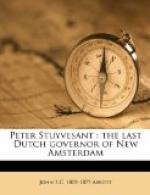He received a good academic education, becoming quite a proficient in the Latin language, of which accomplishment, it is said that he was afterwards somewhat vain. At school he was impetuous, turbulent and self-willed. Upon leaving the academy he entered the military service, and soon developed such energy of character, such a spirit of self-reliance and such administrative ability that he was appointed director of the colony at Curacoa. He was recklessly courageous, and was deemed somewhat unscrupulous in his absolutism. In an attack upon the Portuguese island of Saint Martin, in the year 1644, which attack was not deemed fully justifiable, he lost a leg. The wound rendered it necessary for him to return to Holland in the autumn of 1644, for surgical aid.
Upon his health being re-established, the Directors of the West India Company, expressing much admiration for his Roman courage, appointed him Governor of their colony in New Netherland, which was then in a state of ruin. There were also under his sway the islands of Curacoa, Buenaire and Amba. The Provincial Government presented him with a paper of instructions very carefully drawn up. The one-man power, which Kieft had exercised, was very considerably modified. Two prominent officers, the Vice-Director and the Fiscal, were associated with him in the administration of all civil and military affairs. They were enjoined to take especial care that the English should not further encroach upon the Company’s territory. They were also directed to do everything in their power to pacify the Indians and to restore friendly relations with them. No fire-arms or ammunition were, under any circumstances, to be sold to the Indians.
Van Diricklagen was associated with the Governor as Vice-Director, and ensign Van Dyck, of whom the reader has before heard, was appointed Fiscal, an important office corresponding with our post of Treasurer. Quite a large number of emigrants, with abundant supplies, accompanied this party. The little fleet of four ships left the Texel on Christmas day of 1646. The expedition, running in a southerly direction, first visited the West India islands. On the voyage the imperious temper of Stuyvesant very emphatically developed itself.
Holland was then at war with Spain. A prize was captured and the question arose respecting its disposal. Fiscal Van Dyck claimed, by virtue of his office, a seat at the council board and a voice in the decision. The governor rudely repulsed him with the words,
“Get out. Who admitted you into the council. When I want you I will call you.”
When they arrived at Curacoa, Van Dyck again made an attempt to gain that place in the Council to which he thought his office legitimately entitled him. Stuyvesant punished him by confining him to the ship, not allowing him to step on shore. All the other officers and soldiers were freely allowed to recruit themselves by strolling upon the land.




